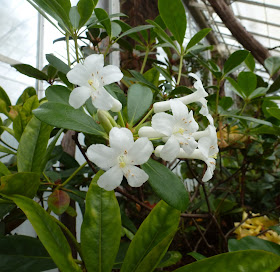Suzanna Hsu, a longtime friend and colleague from my art teaching days, asked me to help her mount an art exhibit of her paintings at the Half Hollow Hills Library.
The gallery space was downstairs. We carefully wrapped all framed paintings in blankets and placed them in our SUVs back to back, front to front, trying not to damage anything.
Fortunately, the library was using the Walker Display, of Connecticut, system of hanging artworks. The system consists of moldings, hanging rods, and two types of clips. The beauty of this system is that you can slide the rods along the molding, and also slide the clips up and down on the rods, making the hanging of paintings simple. It also eliminates putting holes in walls and re-Spackling.
The first paintings we hung came in a series of three square unframed pieces. For this arrangement, we measured the clips on each rod to match, and used the large clip which notched into the back of the wooden stretcher. We used the shorter rods because we did not want them to show below the artworks. Each painting was placed, considering the directionality of the composition. Some were left facing and some were right facing.
Suzanna is adjusting the paintings on the second wall, for height. This second wall went quickly because the paintings were closely related in color and subject.
We started with the center, and placed the largest piece in a dark frame, and worked outwards to the ends of the walls. At first we thought that we should match the bottoms or the tops of the paintings, but later decided to split the difference and work from the center up and down. The paintings were placed on the floor below the rods, at first, and after shuffling them around for color flow, we put them on the rods, and adjusted them for height.
We borrowed a ruler, ladder, and pliers from the library. But we should have brought a 25 foot tape measure or a laser marker and level. Anyway, we eyed the arrangement and it came out well. Adjusting the paintings really took the two of us, one on a ladder, and one at a distance. Having someone stand back to look at the walls from afar, was essential.
On the third wall, Suzanna placed her favorite painting. This was the wall which would be seen from one of the entry points.
She steps back to see if the height is correct.
We arrange the other paintings on that wall.
On of the things that we tried to do was to get the colors to flow around the room in a continuous wave. Colors in one painting were picked up in the next painting.
By moving the paintings around, we achieved this successfully.
The last wall was the most difficult because the paintings were less connected in color, and subject. We placed them on the least prominent wall, the wall not seen from the stairs or from the entrance hallway.
On this wall, the painting on the left continued the color scheme from the previous wall.
Suzanna Hsu
She arranged a guest book for comments, and her calling cards.
Suzanna's exhibition is open to the public for the month of April, 2013.























































